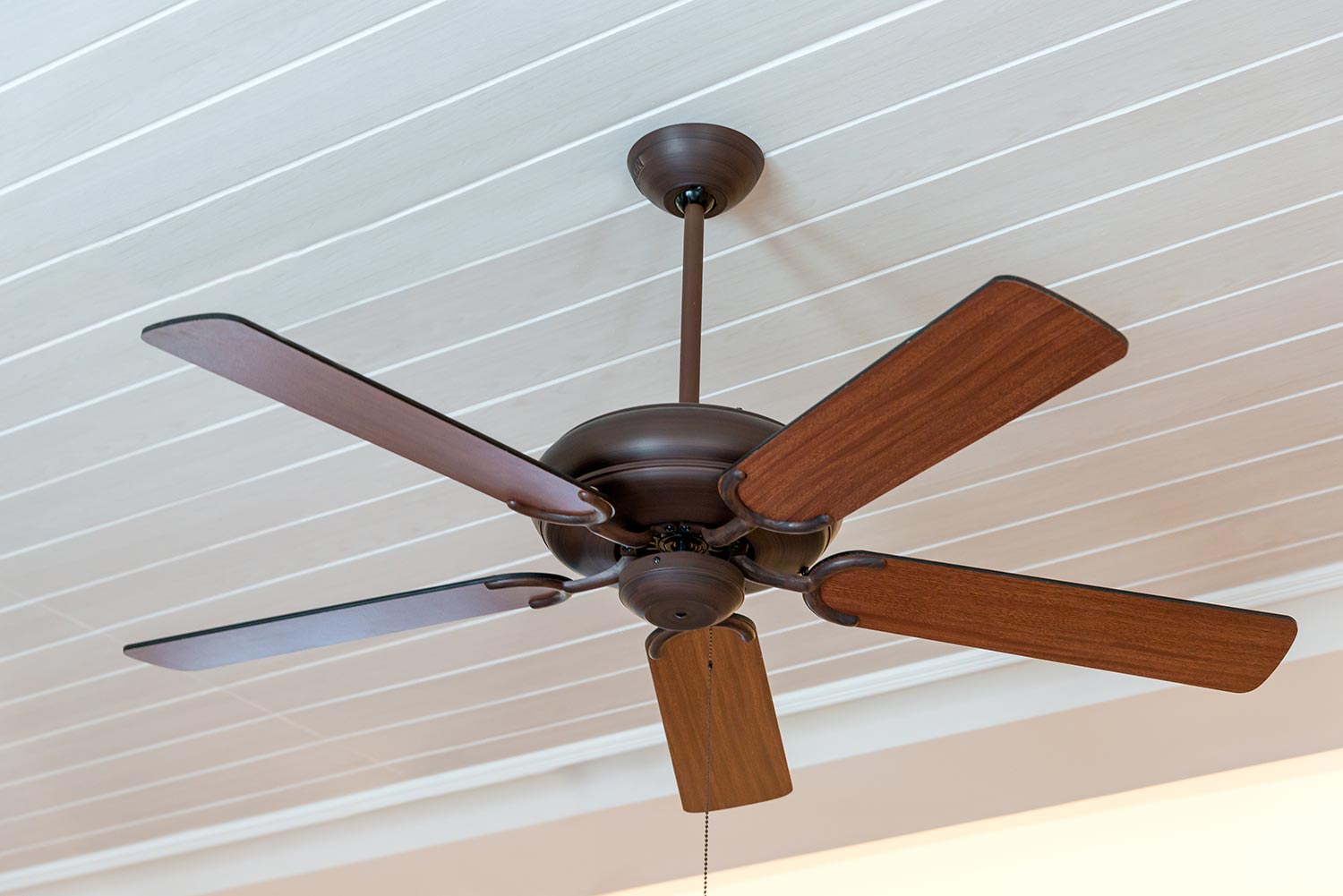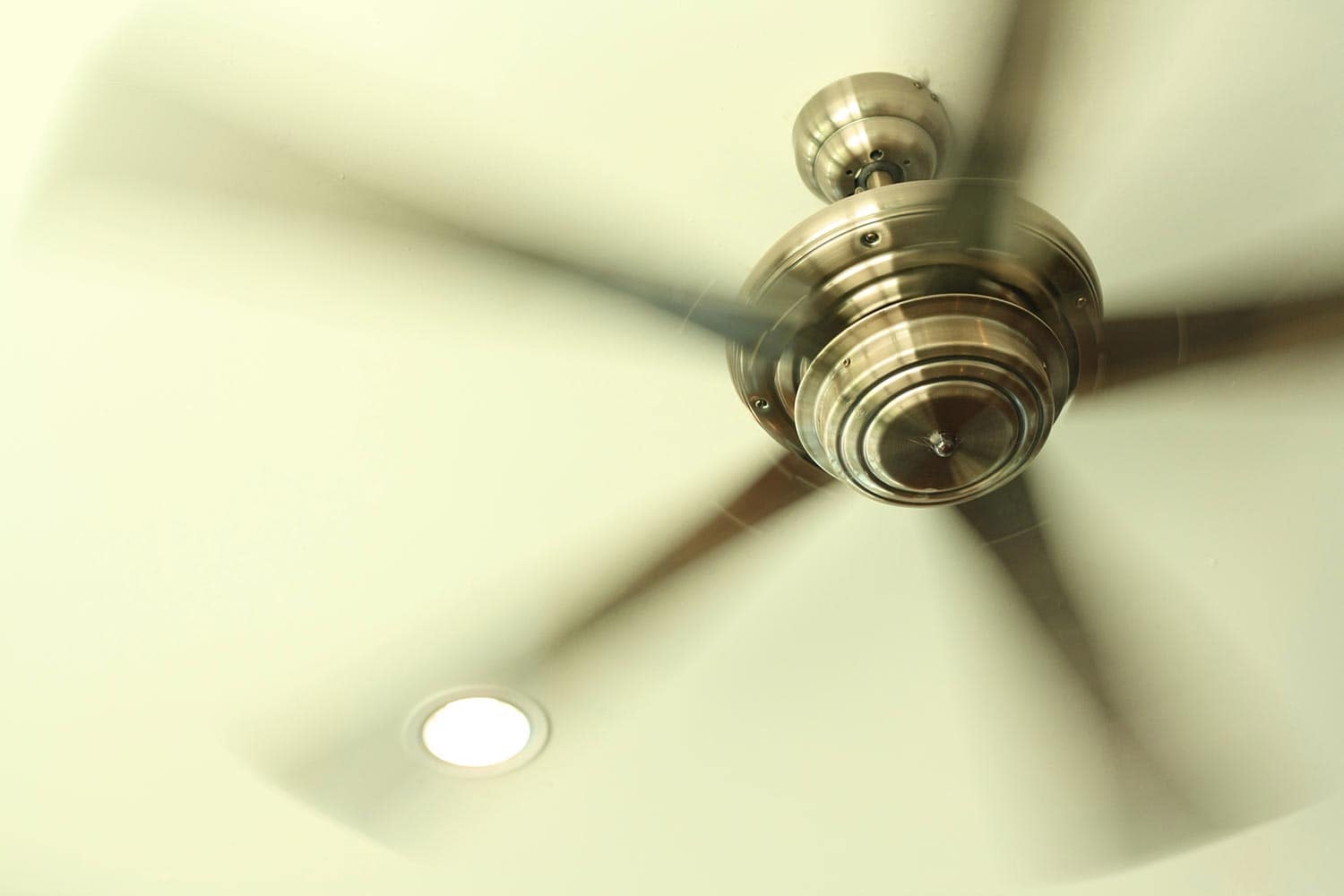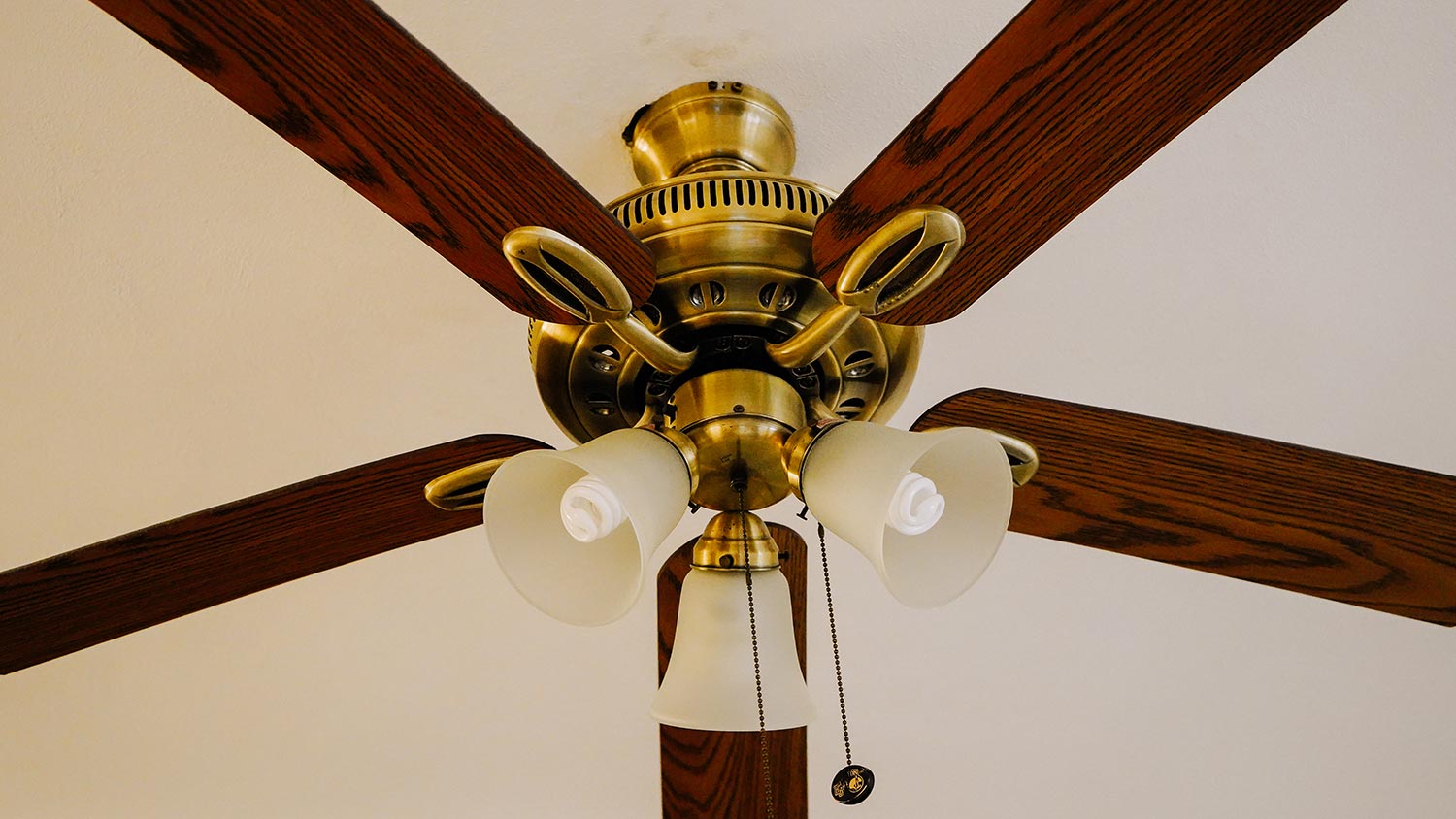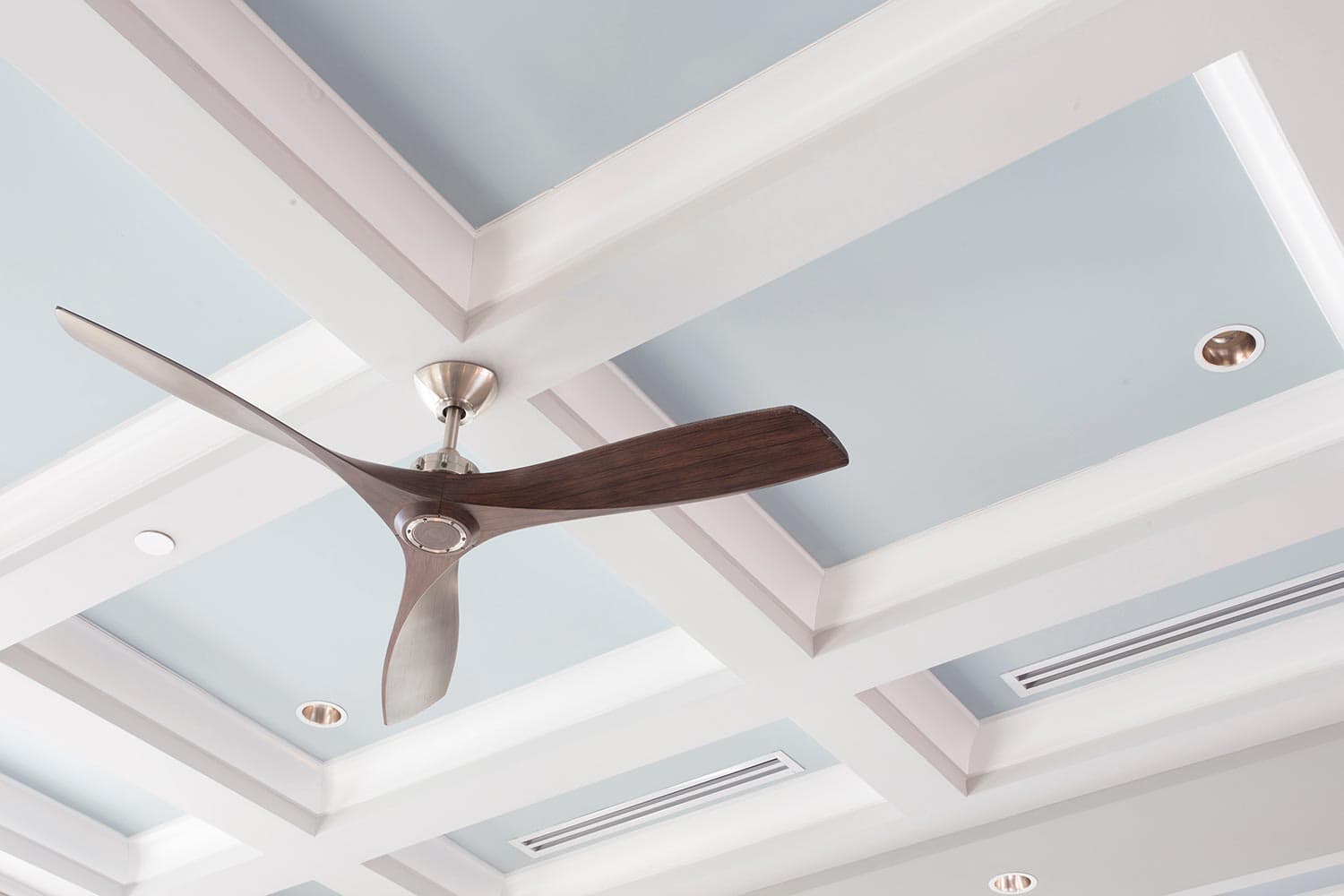You are planning to install a new ceiling fan or perhaps remove an old one. Because of this, you are wisely wondering how much a ceiling fan weighs. This post gathers up-to-date research from around the web to thoroughly answer your question.
Ceiling fans vary widely depending on several factors. They range from as light as 1 pound to as heavy as 50 pounds. However, most fans weigh between 17 and 20 pounds. The following factors most influence fan weight:
- Fan Material
- Fan Size
- Lights and Other Accessories
- Blade Count
Keep reading the rest of this post for a more detailed discussion on each of the above bullet points, focusing on market available fans and their weights. To conclude, we answer several questions related to the topic of this post and provide a helpful additional reading list.

The Weight of a Ceiling Fan
Material, size, accessories, and blade count all combine to form the final weight of a ceiling fan. The discussion below makes for an effective primer on how much a ceiling fan should weigh considering these features.
However, the only real method for determining fan weight is with a scale or reading manufacturers' labeling or literature.
Fan Material
Fans come in a wide range of materials, including wood, brass, steel, aluminum, and plastic. These materials are also mixed within a single fan on different components.
That is to say; it is not uncommon for the motor housing to be plastic while the blades are a different material altogether. You can find almost any mix of materials on a single fan.
It is common for fan manufacturers to list the primary material as the material used to make the motor housing instead of the blades. Therefore, it is essential to be careful when shopping by fan material online.
Here, we explore a few different fan materials while attempting to keep other variables relatively consistent.
Wood
Click here for a wood-bladed fan from Amazon.
This wood-bladed 50" fan has five total blades, a light, and a brass housing. This fan weighs 20 pounds. Wood-bladed fans generally clock in higher on the scale of total fan weights.

Plastic
Click here for a plastic fan from Amazon.
This all-plastic 46" five-blade fan with lights only clocks in at a surprisingly light 1 pound. However, other plastic fans, which are heavier duty, often also weigh much more.
Metal
Click here for a metal fan from Amazon.
This 52" five-bladed steel fan with light weighs 23.6 pounds. There are many types of metal fans that all come with different weights. But generally, metal is heavier than plastic.

Fan Size
While commercial fans are sometimes larger, ceiling fans generally only range from about 30" to around 75". As you would expect, larger diameter fans weigh more than similarly built smaller fans.
For comparison, we explore the weight of a small, medium, and a large fan in the next three mini-sections.
Small Fan
Click here for a small fan from Amazon.
This 30" fan is primarily steel and weighs a light 12 pounds.
Medium Fan
Click here for a medium fan from Amazon.
This 44" fan weighs about 18 pounds. Its materials are wood, aluminum, alloy steel, and glass.
Large Fan
Click here for a large fan from Amazon.
This 72" fan is billed for outdoor or industrial use but may also be appropriate for large residential homes. It weighs 28 pounds and is primarily made of aluminum.
Lights and Other Features

Fan accessories include lights, light covers, downrods, remote control capabilities, and mounting brackets. All of these have slightly different weights. However, the presence of lights and the type of lights are the features that impart the greatest influence on weight.
Unless the lights and fixtures are very heavy duty, their presence does not make much difference in total fan weight. Take, for instance, the two fans pictured below. These fans are virtually the same model, but one has lights. The one with lights only weighs 0.32 pounds more.
Without Lights
Click here for a fan without lights from Amazon.
This 52" fan is primarily metal and weighs 18.18 pounds.
With Lights
Click here for a fan with lights from Amazon.
This 52" is primarily metal, has lights, and weighs 18.5 pounds.
Blade Count
The more blades a ceiling fan has, the heavier it generally weighs. In the following sections, we examine the weight of 3, 5, and 8 bladed fans to understand the impact that blade count has on total weight.
3 Blades
Click here for a 3-bladed fan from Amazon.
This three-bladed fan is 52", has heavier wood blades, and weighs almost 17 pounds.
5 Blades
Click here for a five-bladed fan from Amazon.
This 52" five-bladed fan is primarily made of wood and metal and weighs 18.74 pounds.
8 Blades
Click here for an eight-bladed ceiling fan from Amazon.
Generally, fans with more blades also have larger diameters. A good example is the eight-bladed 60" fan above, which is primarily made of metal. It weighs 23.3 pounds.
Does the weight of a ceiling fan matter?
Yes, the weight of a ceiling fan does matter. Initially, very heavy fans can be challenging to install or remove because of the additional weight the workman has to lift and maneuver. Further, it is crucial to match the weight of your fan to the strength of the fan mounting bracket.
If you overload the bracket, you can end up with a fan that falls from the ceiling. Remember, just because a fan holds initially does not mean it will not fail eventually or under the added stress of spinning blades.
According to Elliott Electric, an electrical supply company, different metal junction boxes will support fans from about 35 to 70 pounds. This means that it may be inappropriate to change out a light fan for a hefty fan.
Further, the metal junction boxes are designed to hold different weights for fans and fixtures because fixtures do not rotate and move. For example, the metal junction boxes that can hold a 70-pound fan can hold a 90-pound fixture.
How much weight can a ceiling fan hold?
Generally, the junction box that the fan is hooked to will be the fail point should you choose to hang additional weight off of your fan. Because they are cheaper, contractors and builders prefer junction boxes designed to only hold a 35-pound fan when possible.
These particular junction boxes are usually designed to hold 50 pounds of non-rotating weight. Therefore, if you do not turn your fan on, you could theoretically hang 15 pounds or more off the fan depending on the fan's weight [usually included in the owner's manual].
That being said, many blade materials are not particularly sturdy and may break under a much lower weight limit. Further, larger, more sturdy junction boxes may be able to hold much more.
However, it isn't easy to understand what kind of junction box is hidden within your drywall without doing some first-hand investigation. Therefore, be very cautious about hanging anything off your ceiling fan until you are sure the weight will not cause damage.
How can you tell if your ceiling can support a ceiling fan?

As mentioned above, it is a specialized junction box, not the ceiling, that supports the weight of the ceiling fan. Therefore, if you can install one of these boxes or already have one of these installed, you should be able to hang a ceiling fan.
On the other hand, it is inadvisable to hang a ceiling fan if you cannot hang a specialized fan junction box.
Can you hang a ceiling fan where a light was?
It is possible to use a light's electricity to hang a ceiling fan. However, it is highly advised that you also take the time to hang a fan-specific junction box in place of the more lightweight light fixture junction box.
While performing any electrical work or making cuts near wires be sure to turn off the breaker or, better yet, hire a licensed electrician.
To change out your junction box, it is often possible to access your rafters in your attic to hang the box. When entering a tight space like an attic, be sure to wear proper PPE such as eye, breathing, and hand protection.
Other times, you may have to cut an access hole into your ceiling space. Be sure to make this hole large enough to install the junction box but small enough that it is covered by the eventual fan mounting hardware.
Additional Reading
To learn more about ceiling fans, read these great articles from HVAC Seer:
- How To Turn On A Ceiling Fan Without A Remote
- Are Ceiling Fan Downrods Interchangeable?
- How To Install A Ceiling Fan In An Apartment?
In Closing
This post covered how much ceiling fans weigh based on material, size, accessories, and blade count. We also answered some helpful related questions and provided a great additional reading list. Good luck!











